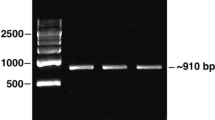Abstract
Nucleoside diphosphate kinase (NDPK, EC 2.7.4.6) is a housekeeping gene, which functions in the general homeostasis of cellular nucleoside triphosphate (NTP) pools. Among the various NDPK isoforms, cytosolic NDPK1 has been shown to be the main NDPK isoform in plants, accounting for more than 70 % of total NDPK activity in plants. For the first time, a full-length cDNA (697 bp), designated as CsNDPK1 was cloned from tea leaves and consisted of a 448-bp open reading frame (ORF) encoding a 147-amino-acid polypeptide with calculated molecular mass of 16.1 kDa and a pI of 6.3. Homology modeling of CsNDPK1 shows that the presented tea NDPK1 also contains several motifs, binding and catalytic sites which are highly conserved among other NDPKs. Docking studies of CsNDPK1 with its substrates (NTPs) are discussed in detail. In summary, we describe a reliable model of CsNDPK1 that can be used in structure-based protein–protein interaction studies for identifying its potential role in intracellular communication and its physiological significance in tea.




Similar content being viewed by others
References
Cipollini, G., Berti, A., Fiore, L., Rainaldi, G., Basolo, F., Merlo, G., Bevilacqua, G., & Caligo, M. A. (1997). International Journal Cancer, 73, 297–302.
Johansson, M., Hammargren, J., Uppsall, E., Mackenzie, A., & Knorpp, C. (2008). Plant Science, 174, 192–199.
Dorion, S., Matton, D. P., & Rivoal, J. (2006). Planta, 224, 108–124.
Hasunuma, K., Yabe, N., Yoshida, Y., Ogura, Y., & Hamada, T. (2003). Journal of Bioenergetics and Biomembranes, 35, 57–65.
Janin, J., Dumas, C., Morera, S., Xu, Y., Meyer, P., Chiadmi, M., & Cherfils, J. (2000). Journal of Bioenergetics and Biomembranes, 32, 215–225.
Larsen, K. (2001). Journal of Plant Physiology, 158, 267–272.
Nomura, T., Yatsunami, K., Honda, A., Sugimoto, Y., Fukui, T., Zhang, J., Yamamoto, J., & Ichikawa, A. (1992). Archives of Biochemistry and Biophysics, 297, 42–45.
Pan, L., Kawai, M., Yano, A., & Uchimiya, H. (2000). Plant Physiology, 122, 447–452.
Chunlei, M. A., & Liang, C. (2007). Frontiers of Agriculture in China, 1, 449–455.
Prabu, G. R., Thirugnanasambantham, K., Mandal, A. K. A., & Saravanan, A. (2012). Biologia Plantarum, 56(1), 140–144.
Kyte, J., & Doolittle, R. (1982). Journal of Molecular Biology, 157, 105–132.
Tamura, K., Peterson, D., Peterson, N., Stecher, G., Nei, M., & Kumar, S. (2011). Molecular Biology and Evolution, 28, 2731–2739.
Laskowski, R. A., MacArthur, M. W., Moss, D. S., & Thornton, J. M. (1993). Journal of Applied Crystallography, 26, 283–291.
Eisenberg, D., Luthy, R., & Bowie, J. U. (1997). Methods in Enzymology, 277, 396–404.
Wiederstein, M., & Sippl, M. J. (2007). Nucleic Acids Research, 35, W407–W410.
Kamps, M. P., & Sefton, B. M. (1986). Molecular and Cellular Biology, 6, 751–757.
Thirugnanasambantham, K., Prabu, G. R., Senthilkumar, P., Suresh Ramraj, S. C., & Mandal, A. K. A. (2011). Plant Physiology and Biochemistry, 49, 565–571.
Acknowledgments
Authors are thankful to Dr. P. Mohan Kumar, Director and Dr. N. Muraleedharan, Adviser of UPASI Tea Research Foundation for their encouragement and support during the course of study. Financial assistance from NTRF, Tea Board, Kolkata, is also gratefully acknowledged. Computational support provided by Mr. P. Sivasanmugam, Department of Bioinformatics, Jamal Mohamed College, Tamil Nadu, India, is also gratefully acknowledged.
Author information
Authors and Affiliations
Corresponding author
Rights and permissions
About this article
Cite this article
Prabu, G., Thirugnanasambantham, K. & Mandal, A.K.A. Structural and Docking Studies of a Nucleoside Diphosphate Kinase 1 (CsNDPK1) from Tea [Camellia sinensis (L.) O. Kuntze]. Appl Biochem Biotechnol 168, 1907–1916 (2012). https://doi.org/10.1007/s12010-012-9906-2
Received:
Accepted:
Published:
Issue Date:
DOI: https://doi.org/10.1007/s12010-012-9906-2




